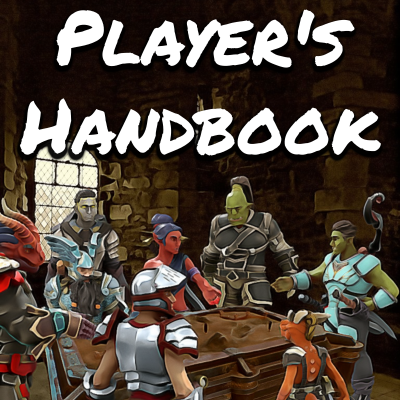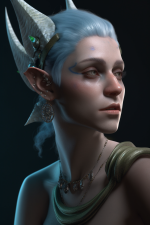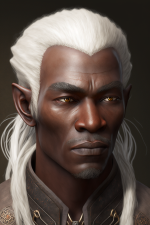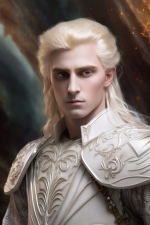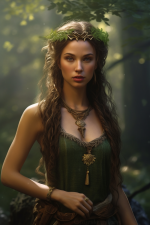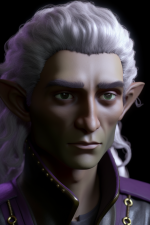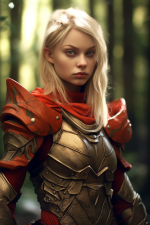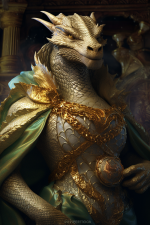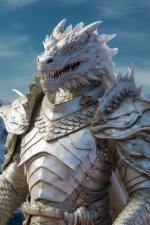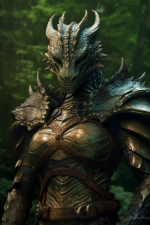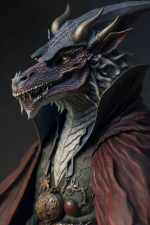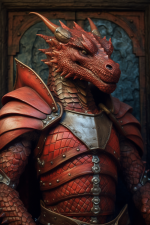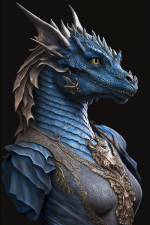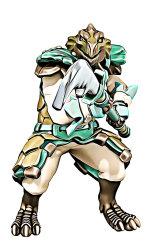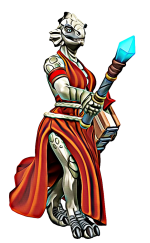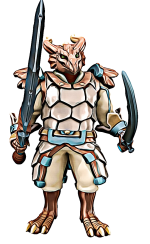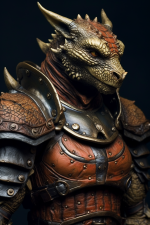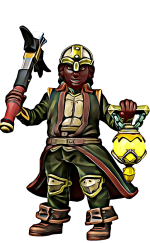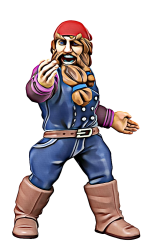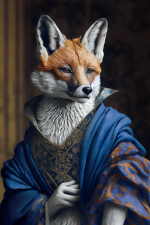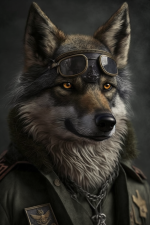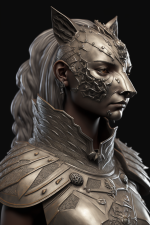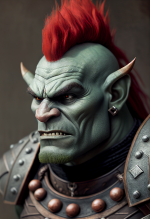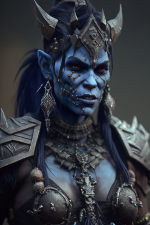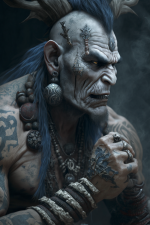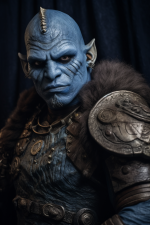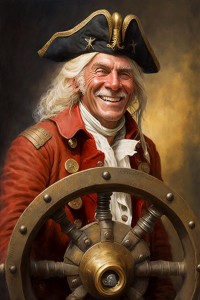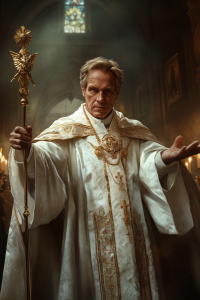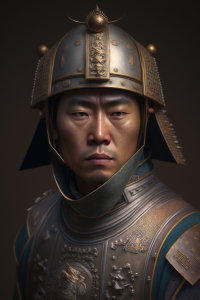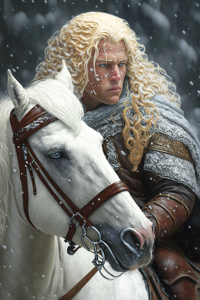Difference between revisions of "Player's Handbook"
(→Human) |
|||
| Line 136: | Line 136: | ||
===[[Human]]=== | ===[[Human]]=== | ||
| + | |||
| + | |||
| + | |||
| + | ===[[Araldiktar]]=== | ||
| + | [[File:Araldiktar.png|left|200px|A typical Araldiktar]] | ||
| + | These islander people hail from the island nation of [[Araldar]] on the western edge of Otan. They are often easily identified by their western dialect of the Otani, their wind-beaten bronze complexions and dark features. The [[Araldiktar]] are naturally enamored with all things maritime and in particular the fruits of the sea. | ||
| + | |||
| + | The [[Araldiktar]] are often considered to be bilingual as they can nearly universally speak the [[Otani language]] but also the [[Araldar pidgin]], which is a hybrid mixture of the [[Otani language|Otani]], [[Sweardælf language|Sweardælf]] and [[Ælfish language]]s. [[Araldar pidgin]] is spoken almost exclusively on the smaller [[Araldar]] languages. | ||
| + | |||
| + | [[Mujitism]] is the most common religion shared by the [[Araldiktar]] people. This sea-oriented religion is comprised of legends of a nautical nature with the heroes engaging with, or even becoming sea creatures. The morals of this religion affect [[Araldar]] culture giving lessons that involve respect for the sea and the creatures within. | ||
| + | |||
| + | The sea is the central source of food for the [[Araldiktar]] and naturally the people are therefore inclined to have deep understandings of what is to be at sea. From an early age, the [[Araldiktar]] will acquire nautical skills such as fishing, sailing and swimming among others. [[Araldiktar]] trades can include farming and other more traditional inland occupations, but more than half the population live adjacent to or on the sea at any given time. The highest paying occupations will typically involve a life at sea. | ||
| + | <br style="clear: both;"> | ||
| + | |||
| + | Batistiktar]]=== | ||
| + | [[File:Batistiktar.png|left|200px|A typical [[Batistiktar]]]] | ||
| + | The natives of western [[Otan]] known as the [[Batistiktar]], mainly inhabiting the country known as the [[Batis|Republic of Batis]]. Formerly a very withdrawn people, it came to the world's attention that the [[Batistiktar]] were exceptional farmers. It is said that, | ||
| + | "For every handful of grain that [[Batistiktar]]s sew, they yield seven more." | ||
| + | The [[Batistiktar]] are also very talented with animal husbandry, raising bison, and other animals with high yields of meat. While they only harvest what they need, in recent years they have begun trading with neighboring [[Soltustik]], which needed supplies during the [[Grendel war]]. Their contribution during the war led to widespread knowledge of their agricultural prowess. It was not long before the [[Kuuliki Trade Company]] had established shipping routes to every major coastal city in the [[Batis|Republic of Batis]]. | ||
| + | |||
| + | At the present time, [[Batistiktar]] produced foodstuffs are shipped worldwide via the coastal routes and to [[Soltustik]] and [[Ælfgarade]] via land routes. The country's increased reliance on trade, for which they import everything from metal to magic, has caused them to sew and harvest many times what the country itself would consume. | ||
| + | |||
| + | The [[Batistiktar]] will sporadically practice [[Wodenism]] as a religion, but tend to prefer their own animistic religions with gods representing each of the major species of wildlife in [[Batis]]. This religion is passed through the oral tradition, and though it lacks the bookishness of other religions, it is rich in religious art. Symbols for the wolf, raven or orca can be recognized immediately by any [[Batistiktar]] and these symbols will often adorn their homes and holy places. | ||
| + | |||
| + | The people themselves can be typically distinguished by their darker features; tanned skin, brown eyes and black hair, often worn long by both males and females. As adventurers, the [[Batistiktar]] produce an unsurprisingly high number of rangers, druids and rogues due to their close connection with the natural world. This is a generalization, of course, as is possible for a [[Batistiktar]] to be produced of any skin/eye/hair color possible for a human with a calling to any of the adventurer archetypes. | ||
| + | |||
| + | <br style="clear: both;"> | ||
| + | |||
| + | Ontustikter]]=== | ||
| + | [[File:Ontustikter.png|left|200px|An [[Ontustikter]] religious leader]] | ||
| + | These southern people of [[Ontustik]] are generally recognizable by their olive complexions, brown eyes and thick black hair. Their most common feature, however, is not physical. They are noted for their devotion to [[Aspan]], the god of the sky and other deities of the [[Aspanism|Aspanist]] religion. In this regard, few [[Ontustikter]]s would be found without clothing and/or symbols that are deferential to these gods and their religion. | ||
| + | |||
| + | |||
| + | |||
| + | <br style="clear: both;"> | ||
| + | |||
| + | Ortalykshilar]]=== | ||
| + | [[File:Ortalykshilar.png|left|200px|A typical Ortalykshilar]] | ||
| + | These central plains people are a melting pot, of most of the people of [[Otan]]. The [[Ortalykshilar]] come in every size, shape, hair colour and skin tones ranging from snow white to ebony black. While there is no one type of [[Ortalykshilar]] the majority are fair skinned, with square jaws and hair ranging from red to brown. | ||
| + | |||
| + | Due to their central location, The [[Ortalykshilar]] are far more likely than other humans on Otan to have business and personal relationships with other humanoids including, but not limited to [[Ælf]]es, [[Dweorg]]es, [[Aydahar]] and even their former enemies, the [[Grendel]]. It is not unusual to find [[Kuulik Trade Company]] representatives facilitating trade in [[Ortalyk]]'s major cities and this all ties into the ''center of the universe'' culture that the [[Ortalykshilar]] have created. | ||
| + | |||
| + | The [[Ortalykshilar]] have a culture that is particularly respectful to [[Woden]], [[Wodenism]] and the gods within that pantheon. The capitol of [[Kala Astanals]] is the holy city of that religion and through the [[Ortalykshilar]], take the message of [[Woden]] to every nation in [[Otan]]. | ||
| + | |||
| + | While every [[Ortalykshilar]] is likely to speak the common [[Otani language]], it is not unusual for an [[Ortalykshilar]] to speak one of any of the other languages of their trading partners. | ||
| + | |||
| + | <br style="clear: both;"> | ||
| + | |||
| + | Sigis Turgindar]]=== | ||
| + | [[File:SigisTurgindar.png|left|200px|A typical Sigis Turgindar]] | ||
| + | These eastern people of Otan are extremely wrapped in their many traditions. Few things in the society of the Sigis Turgindar take place without the ceremony and accoutrements of centuries past. The Sigis Turgindar are incredibly respectful of their ancestors, who they believe continuously evaluate their lives from the afterlife. | ||
| + | |||
| + | These eastern people practically worship quality craftsmanship, creating some of the best trade goods the world has to offer. This has resulted in some extensive trade routes, which extend from their home country of Sigis around the world. | ||
| + | |||
| + | The features of the Sigis Turgindar can vary greatly with a range of skin tones, though their hair color is consistently darkish brown to black. In rare cases they might have green, hazel or even yellowish eyes. | ||
| + | <br style="clear: both;"> | ||
| + | Karazaliktar]]=== | ||
| + | [[File:Karazaliktar.png|left|200px|A typical Karazaliktar]] | ||
| + | These southern people of [[Otan]] are a matriarchal society and have deep ties that interweaver their animist religion with their local and even national politics. [[Karazaliktar]] culture begins with the belief that the females of their people are born with complete souls, while the males must strive to collect the missing parts souls through a long process of study and religious penitence. Males who do not complete the collection of their souls are said to be lost, unable to join the gods in the heavens or to be reborn. | ||
| + | |||
| + | The [[Karazaliktar]] elders play a large part in society, often providing the education that the males need to collect the missing parts of their souls. They also offer advice and training to up and coming generations and are consulted upon in all matters of importance to the community (or nation). The unofficial leader of and [[Karazaliktar]] tribe is referred to as the [[Queen Mother]] as is the leader of the entire country. Males may serve roles in government, but only in very rare cases will hold the highest levels of power or control. | ||
| + | |||
| + | These [[Karazaliktar]] generally largely brown skin of various tones from cocoa powder to nearly black. They also have black hair and brown eyes, though elders may have hair from grey to white. Some variations in color exist, of course, but they are rare. The [[Karazaliktar]] speak the common [[Otani language]] but unlike many of their northern counterparts, worship [[Baksism|Baksist]] gods such as [[Ana]] and [[Jer] rather than follow the more common [[Wodenism|Wodenist]] beliefs. | ||
| + | |||
| + | [[Karazaliktar]]'s have a close connection to nature, through their religious and cultural beliefs and when feeling adventurous, have a natural inclination to take up such professions such as ranger or druid. In other professions, they prefer to choose paths that involve a closer connection to or power over/through nature. | ||
| + | |||
| + | <br style="clear: both;"> | ||
| + | |||
| + | Soltustikter]]=== | ||
| + | [[File:Soltustikter.png|left|200px|A typical Soltustikter]] | ||
| + | The northern [[Soltustikter]]'s are very nearly defined by the terribly cold weather of their native country of [[Soltustik]]. Forever plunged into cold climate, the [[Soltustikter]]s are adept and skills to keep themselves warm. They have a natural resistance to cold which enables them to operate in temperature that would leave other people of [[Otan]] quite stiffly frozen. | ||
| + | |||
| + | [[Soltustikter]] society side is feudal and sides toward a patriarchal model, though the divisions of labor are split between the sexes. Even the role of king is currently filled by a woman, Queen [[Kara Muz]]. Smaller [[Soltustikter]] regions, called Baronies will have a Baron or Baroness who pays homage to the queen. Each settlement in a Barony will have a Governor who pays homage to the Baron and each citizen of the land will pay homage to one Governor or the other. | ||
| + | |||
| + | Worship in [[Soltustik]] is almost entirely [[Wodenism|Wodenist]]. There is no question in the [[Soltustikter]] mind that there is only one pantheon worthy of worship and that its primarch is [[Woden]]. [[Soltustikter]]'s will invoke the name of [[Woden]] or his nearly 1,000 nicknames in every other sentence if possible. | ||
| + | |||
| + | Northerners range in skin tones from pinkish to pure white, with light features. Their hair colour can range from light blonde to black and their eyes can be of any color though typically are of blue or green. Other variations with [[Soltustikter]] communities are rare though they tend to produce more [[Half-Ælf]]es than other cultures due to their proximity to [[Ælfwode]]. | ||
| + | <br style="clear: both;"> | ||
===[[Kuulik]]=== | ===[[Kuulik]]=== | ||
Revision as of 22:10, 20 January 2022
Player Races
The following are races that may be played by characters in the Otan setting.
Ælf
Legend has it that Ælfes (🔊 Alfs) were put on Otan by Woden himself when the world began. Since then the Elves have divided themselves into three major factions, the Wodælfes, Dunælfes, and Friggælfes. Their differences surround that which they believe to be the true aesthetic. Players wishing to create an Ælf character may choose from one of the following six variants.
| The Brimælfes (🔊 Brim-alf) live undersea, primarily off the coast of Ælfgarad. They prefer to stay beneath the waves and as a result, have little to do with their Ælfen siblings ashore. | The Dunælf (🔊 Dunn-alf) grew distant from their Ælfen cousins again because of an aesthetic preference. The Dunælf preferred darker features in skin tone and over many years, bred accordingly. | The Friggælf (🔊 Frig-alf) is the predominant race and culture in the country of Ælfgarad. They were once intermixed with their Wodælf and Dunælf cousins until rifts in their sense of the artistic aesthetic came to the forefront of their culture and politics. | The Wodælf (🔊 Woah-dalf) are, not surprisingly, the preeminent race and culture found in Ælfwode. They were, most believe, the only variety of Ælf to exist. Their love for Woden and his creation extended to the forests and nature in which they lived. | The Wyrmælf (🔊 Verm-alf) are distant relatives of the Aydahar and by extension, dragons. The Ælfen predilection toward the aesthetic, however, caused them to carefully manage their genetic lines. | The Half-Ælf are half human and Ælf. It is possible on Otan for a Half-Ælf to possess a bloodline which does not have a human half, but this variety of hybrid should be discussed with the DM before creation. |
Aydahar
The Aydahar are a race of draconic-infused humans originally of human origin, but whose ancestors and sometimes parents are of a draconic lineage. When it was learned that dragons and humans could produce offspring, the races of the Aydahar and the similarly draconic blooded Ungir soon came into being.
| The Altin Aydahar of the Altin Aydahar Region, the gold dragon and capitol region of the Aydahar Confederation. The Altin Aydahar have golden-colored skin and features similar to that of their draconic ancestors. | The Aq Aydahar of the white dragon or Koke Aydahar Region have a white coloring to their skin and features that match those of their draconic ancestors. | The Jasil Aydahar are native to the Jasil Aydahar Region of the Aydahar Confederation. They inherit their genetic makeup from green dragon ancestors or possibly even an adult (or older) green dragon parent. | The Jez Aydahar Region of the Aydahar Confederation is home to the hot blooded Jez Aydahar, who share their genetic makeup with brass dragon ancestors. | Native to the Kara Aydahar Region of the Aydahar Confederation, the Kara Aydahar share their genetic makeup with black dragon ancestors. A Kara Aydahar individual may actually have a draconic parent. | The Kizil Aydahar Region of the Aydahar Confederation is home to the hot blooded Kizil Aydahar, who share their genetic makeup with red dragon ancestors. |
| The Koke Aydahar of the Koke Aydahar Region have a blue coloring like that of their draconic ancestors. They can also be distinguished by the rhinoceros like horn on their snouts. | The Kola Aydahar of the Kola Aydahar Region have a bronze coloring like that of their bronze dragon ancestors. They can also be distinguished by the multiple fans and spikes on the backs of their heads. | The Kumis Aydahar of the silver dragon or Kumis Aydahar Region have a metallic silver shine to their skin and features that match those of their silver draconic ancestors. | Native to the Mis Aydahar Region of the Aydahar Confederation, the Mis Aydahar share their genetic makeup with copper dragon ancestors. A Mis Aydahar individual may actually have a draconic parent. | Half-Aydahar can be found throughout much of the Aydahar Confederation and the Free States. They can live in any country on Otan more or less safely, however they prefer to be near others who share draconic blood. |
Dweorg
The Dweorges are a race with a predilection toward mining. A short conversation with a Dweorg will reveal their life's philosophy, which can be reduced to a simple motto; "Treasures await beneath." Genetic and cultural compulsions aside, this motto alone tempts the Dweorges to dig.
| The City Dweorges are the most common variety of Dweorges, inhabiting every city and surrounding area where Dweorges can be found. | The Deep Dweorg are the Dweorgen diggers. These rarely see the surface of Otan and few are known outside of their chosen communities and dig sites. | The Sea Dweorges have a penchant for harvesting the treasures of the oceans. The have made a reputation for themselves in Otan as purveyors of coral, pearls, and other oceanic treasures. | The Half-Dweorg is a hybrid race, half human and half Dweorg. They may have traits and features of either race. |
Garis
Garis legend speaks of a time when the Garis did not inhabit Otan but traveled through the heavens. Always looking to the stars, they have survived and even thrived on Otan, but never feel at home. It seems that endless internal conflict and factional disputes will keep them grounded indefinitely. There are three distinct variant races of Garis which are most readily noted by the shape of their muzzles.
| The Akimsilik are a Garis variant with vulpine features such as a narrow snout and fluffy tail. They live mostly in the Akimsilik Region of the Garis Triumvirate. | The Beybitsilik sport hyena-like features with a short snout, and their heads often crested with a mane that starts from their foreheads and goes down past the back of their necks. | The Ustemdik are another fur covered variant of Garis with strong lupine features and an intimidating gaze. Their fur colorings tend range from black to white with all shades of grey in between. | The Half-Garis are a variant of the Garis race with additional with additional Human bloodlines. They may have varying amounts of fur of nearly any color, and nearly any color of skin beneath. |
Grendel
The Grendel have little patience for human politics and have set out on several occasions to destroy all that is human. Encouraged by the half-human, Half-Grendel warlock Zoranthar Zhanat, the Grendel made war on Ortalyk and Soltustik with varying degrees of success. Only the Accord of Kala Astanals stayed their hands from seeking more human blood.
| The Kalas Grendel are the backbone of Grendel civilization, populating the cities, entering trade and fueling the economy. | The Maerc Grendel are the salt of the Grendel soil. They populate the marshy areas surrounding larger Grendel populations, living off the land and keeping the settlements safe. | The Sogis Grendel are the backbone of Grendel military might. They are raised on a diet of martial training and contempt for the enemies of the Grendel. | The Half-Grendel are hybrids of Human and Grendel ancestry. They may possess dominant traits and features from either lineage. |
Human
Araldiktar
These islander people hail from the island nation of Araldar on the western edge of Otan. They are often easily identified by their western dialect of the Otani, their wind-beaten bronze complexions and dark features. The Araldiktar are naturally enamored with all things maritime and in particular the fruits of the sea.
The Araldiktar are often considered to be bilingual as they can nearly universally speak the Otani language but also the Araldar pidgin, which is a hybrid mixture of the Otani, Sweardælf and Ælfish languages. Araldar pidgin is spoken almost exclusively on the smaller Araldar languages.
Mujitism is the most common religion shared by the Araldiktar people. This sea-oriented religion is comprised of legends of a nautical nature with the heroes engaging with, or even becoming sea creatures. The morals of this religion affect Araldar culture giving lessons that involve respect for the sea and the creatures within.
The sea is the central source of food for the Araldiktar and naturally the people are therefore inclined to have deep understandings of what is to be at sea. From an early age, the Araldiktar will acquire nautical skills such as fishing, sailing and swimming among others. Araldiktar trades can include farming and other more traditional inland occupations, but more than half the population live adjacent to or on the sea at any given time. The highest paying occupations will typically involve a life at sea.
Batistiktar]]===
The natives of western Otan known as the Batistiktar, mainly inhabiting the country known as the Republic of Batis. Formerly a very withdrawn people, it came to the world's attention that the Batistiktar were exceptional farmers. It is said that,
"For every handful of grain that Batistiktars sew, they yield seven more."
The Batistiktar are also very talented with animal husbandry, raising bison, and other animals with high yields of meat. While they only harvest what they need, in recent years they have begun trading with neighboring Soltustik, which needed supplies during the Grendel war. Their contribution during the war led to widespread knowledge of their agricultural prowess. It was not long before the Kuuliki Trade Company had established shipping routes to every major coastal city in the Republic of Batis.
At the present time, Batistiktar produced foodstuffs are shipped worldwide via the coastal routes and to Soltustik and Ælfgarade via land routes. The country's increased reliance on trade, for which they import everything from metal to magic, has caused them to sew and harvest many times what the country itself would consume.
The Batistiktar will sporadically practice Wodenism as a religion, but tend to prefer their own animistic religions with gods representing each of the major species of wildlife in Batis. This religion is passed through the oral tradition, and though it lacks the bookishness of other religions, it is rich in religious art. Symbols for the wolf, raven or orca can be recognized immediately by any Batistiktar and these symbols will often adorn their homes and holy places.
The people themselves can be typically distinguished by their darker features; tanned skin, brown eyes and black hair, often worn long by both males and females. As adventurers, the Batistiktar produce an unsurprisingly high number of rangers, druids and rogues due to their close connection with the natural world. This is a generalization, of course, as is possible for a Batistiktar to be produced of any skin/eye/hair color possible for a human with a calling to any of the adventurer archetypes.
Ontustikter]]===
These southern people of Ontustik are generally recognizable by their olive complexions, brown eyes and thick black hair. Their most common feature, however, is not physical. They are noted for their devotion to Aspan, the god of the sky and other deities of the Aspanist religion. In this regard, few Ontustikters would be found without clothing and/or symbols that are deferential to these gods and their religion.
Ortalykshilar]]===
These central plains people are a melting pot, of most of the people of Otan. The Ortalykshilar come in every size, shape, hair colour and skin tones ranging from snow white to ebony black. While there is no one type of Ortalykshilar the majority are fair skinned, with square jaws and hair ranging from red to brown.
Due to their central location, The Ortalykshilar are far more likely than other humans on Otan to have business and personal relationships with other humanoids including, but not limited to Ælfes, Dweorges, Aydahar and even their former enemies, the Grendel. It is not unusual to find Kuulik Trade Company representatives facilitating trade in Ortalyk's major cities and this all ties into the center of the universe culture that the Ortalykshilar have created.
The Ortalykshilar have a culture that is particularly respectful to Woden, Wodenism and the gods within that pantheon. The capitol of Kala Astanals is the holy city of that religion and through the Ortalykshilar, take the message of Woden to every nation in Otan.
While every Ortalykshilar is likely to speak the common Otani language, it is not unusual for an Ortalykshilar to speak one of any of the other languages of their trading partners.
Sigis Turgindar]]===
These eastern people of Otan are extremely wrapped in their many traditions. Few things in the society of the Sigis Turgindar take place without the ceremony and accoutrements of centuries past. The Sigis Turgindar are incredibly respectful of their ancestors, who they believe continuously evaluate their lives from the afterlife.
These eastern people practically worship quality craftsmanship, creating some of the best trade goods the world has to offer. This has resulted in some extensive trade routes, which extend from their home country of Sigis around the world.
The features of the Sigis Turgindar can vary greatly with a range of skin tones, though their hair color is consistently darkish brown to black. In rare cases they might have green, hazel or even yellowish eyes.
Karazaliktar]]===
These southern people of Otan are a matriarchal society and have deep ties that interweaver their animist religion with their local and even national politics. Karazaliktar culture begins with the belief that the females of their people are born with complete souls, while the males must strive to collect the missing parts souls through a long process of study and religious penitence. Males who do not complete the collection of their souls are said to be lost, unable to join the gods in the heavens or to be reborn.
The Karazaliktar elders play a large part in society, often providing the education that the males need to collect the missing parts of their souls. They also offer advice and training to up and coming generations and are consulted upon in all matters of importance to the community (or nation). The unofficial leader of and Karazaliktar tribe is referred to as the Queen Mother as is the leader of the entire country. Males may serve roles in government, but only in very rare cases will hold the highest levels of power or control.
These Karazaliktar generally largely brown skin of various tones from cocoa powder to nearly black. They also have black hair and brown eyes, though elders may have hair from grey to white. Some variations in color exist, of course, but they are rare. The Karazaliktar speak the common Otani language but unlike many of their northern counterparts, worship Baksist gods such as Ana and [[Jer] rather than follow the more common Wodenist beliefs.
Karazaliktar's have a close connection to nature, through their religious and cultural beliefs and when feeling adventurous, have a natural inclination to take up such professions such as ranger or druid. In other professions, they prefer to choose paths that involve a closer connection to or power over/through nature.
Soltustikter]]===
The northern Soltustikter's are very nearly defined by the terribly cold weather of their native country of Soltustik. Forever plunged into cold climate, the Soltustikters are adept and skills to keep themselves warm. They have a natural resistance to cold which enables them to operate in temperature that would leave other people of Otan quite stiffly frozen.
Soltustikter society side is feudal and sides toward a patriarchal model, though the divisions of labor are split between the sexes. Even the role of king is currently filled by a woman, Queen Kara Muz. Smaller Soltustikter regions, called Baronies will have a Baron or Baroness who pays homage to the queen. Each settlement in a Barony will have a Governor who pays homage to the Baron and each citizen of the land will pay homage to one Governor or the other.
Worship in Soltustik is almost entirely Wodenist. There is no question in the Soltustikter mind that there is only one pantheon worthy of worship and that its primarch is Woden. Soltustikter's will invoke the name of Woden or his nearly 1,000 nicknames in every other sentence if possible.
Northerners range in skin tones from pinkish to pure white, with light features. Their hair colour can range from light blonde to black and their eyes can be of any color though typically are of blue or green. Other variations with Soltustikter communities are rare though they tend to produce more Half-Ælfes than other cultures due to their proximity to Ælfwode.
Kuulik
Misik
Qurilissi
Sweardælf
Ungir
Character Classes
Otan is home to many marvels. To fill the roles of the characters needed to create the smooth operation of Otan society, new character classes needed to be acknowledged. They have been added here for the consideration of DM's and players alike.
